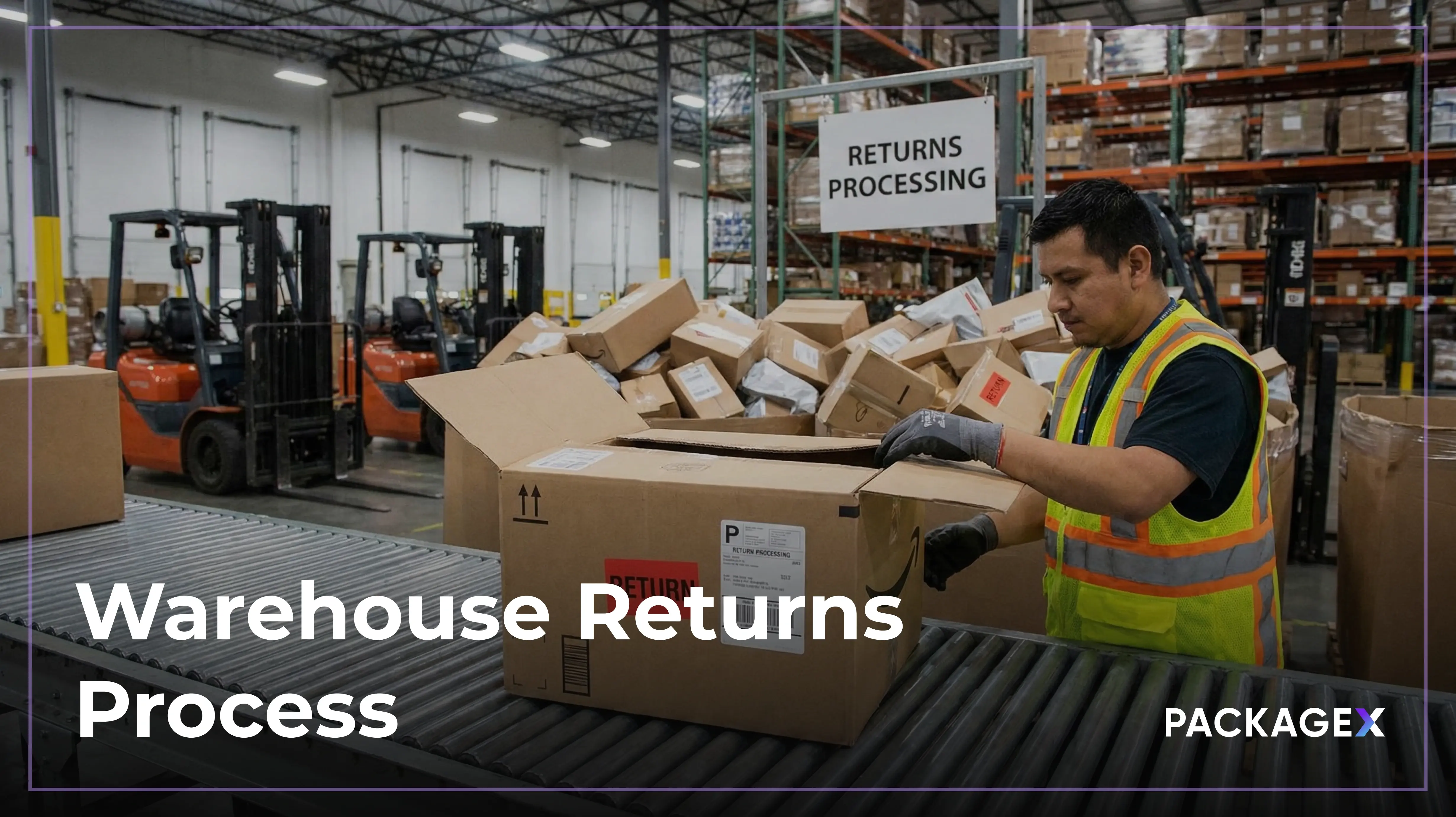Are you tired of playing hide-and-seek with your own inventory? Managing a warehouse can feel like a puzzle, with stock disappearing just when you need it most. But what if you could turn this conundrum into a competitive advantage? Modern warehouse inventory management isn’t just about keeping things organized—it’s about finding hidden efficiencies that can give you a competitive edge. By embracing automation, refining your floor plan, and implementing cutting-edge solutions and automated systems, you’ll not cut costs and boost productivity. Let’s look at the strategies that will transform your warehouse into a well-functioning machine.
What Is Warehouse Inventory Management?
Warehouse inventory management is the process of receiving, tracking, and organizing goods in your warehouse for smooth operations. It means supervising incoming and outgoing stock, optimizing storage space, and keeping inventory levels balanced. By monitoring inventory movement, you can fulfill customer orders faster while keeping storage costs low. Warehouse inventory management also includes replenishing stock when it reaches minimum levels and using data to adjust inventory based on demand. Ultimately, good warehouse inventory management improves productivity, improves order accuracy, and maintains customer satisfaction.
Inventory Management vs Warehouse Management
Inventory management and warehouse management are closely linked parts of supply chain management. So, they work hand in hand to keep goods moving smoothly. Inventory management shows the big picture- it is about deciding how much stock to keep and where to place it. It covers the entire process of tracking stock, from when it’s acquired to when it’s sold. This includes monitoring inventory levels, determining how much stock to keep, and ensuring items are available when needed. It’s a broad system that applies to all stages, whether products are in a warehouse, storefront, or in transit.
Warehouse management deals with the details instead, which are the logistics and storage of those items. This process makes sure that items are well-organized, secure, and easy to find when it’s time to ship them out. So, everything from storing products in predictable locations to efficiently picking, packing, and shipping orders when a sale or transfer is made.
Together, they ensure an efficient flow of products from storage to fulfillment. For businesses with multiple warehouse inventory management, using specialized tools can make the process even smoother by helping track items across facilities and streamline logistics. A warehouse inventory management app would be perfect for that,
What Is the Importance of Warehouse Inventory Management?
Warehouse inventory management is important for your business due to the following reasons:
- Improves order accuracy: A well-organized warehouse helps prevent mistakes in picking and packing, so orders are fulfilled quickly and correctly.
- Multiplies productivity: When inventory is properly stored and managed, manual tasks are minimized. This allows higher-level logistics and growth to receive more attention.
- Speeds up shipping: Efficient warehouse inventory management reduces delays and enables faster shipping by streamlining order processing and expanding distribution networks.
- Saves money: Optimizing storage, automating tasks, and reducing errors can cut labor, storage, and fulfillment costs.
- Happier customers: Quick, accurate deliveries and streamlined returns lead to happier customers and repeat business.
What Exactly Is Inventory Management Process in a Warehouse?
The goal of the warehouse inventory management process is to keep everything running smoothly, making sure you have just the right amount—avoiding excess inventory and shortages. It’s about striking the perfect balance to keep operations efficient. You do this by carefully overseeing your stock, from raw materials to finished products. Let’s look at the steps involved:
Receiving
Check and log incoming inventory, ensuring items are in good condition and in accurate quantities. Warehouse inventory management software with a barcode scanner could really accelerate this process.
Put-Away and Storage
Organize inventory in designated locations; fast-moving items should be stored near shipping areas for quick access.
Order Processing
Confirm customer orders through various methods (in-person, email, phone, or online).
Picking
Use picking aids like voice or batch picking to retrieve products accurately based on orders, minimizing trips and errors.
Packing
Prepare picked items for shipment using protective materials, sealing packages with shipping labels that include tracking information.
Shipping
Document and dispatch orders to customers promptly and accurately for better warehouse inventory management.
Returns
Inspect returned items for damage; restock items if they're in resellable condition; and issue refunds or exchanges.
What Are the Techniques Used in Warehouse Inventory Control?
If you're eager to enhance your warehouse inventory management right away, here are some practical techniques to kickstart improvements:
- ABC Analysis: This method categorizes inventory into three groups (A, B, and C) based on popularity and value. Focus on stocking Category A items to consistently meet consumer demand.
- Perpetual Inventory Management: Use RFID and POS systems to track inventory in real-time. These warehouse inventory management tools ensure a clear view of stock levels.
- Economic Order Quantity (EOQ): Calculate the ideal order quantity using the EOQ formula to minimize costs associated with shortages, orders, and holding inventory.
- Safety Stock Inventory: Good warehouse inventory management practices include keeping extra stock to buffer against supply chain disruptions. Typically, aim for about 50% more than your average inventory to prevent stockouts.
- Batch Tracking: Assign unique batch numbers to monitor expiration dates and quality. The food and pharmaceutical industries should focus on this.
- Dropshipping: This is one of the warehouse inventory management ideas that involves shipping products directly from suppliers to customers, eliminating storage costs and allowing for a broader product range without overhead.
- FIFO and LIFO: Use FIFO to sell older inventory first, keeping stock fresh, or LIFO to sell the newest items first for tax benefits.
- Just-in-Time (JIT) Inventory Management: Order items only as needed, reducing the risk of dead stock and storage costs of warehouse inventory management.
Warehouse Inventory Management Best Practices
Minimize Manual Input
Inventory control and warehouse automation tools like drones, sensors, and RFID tags are used to reduce human error and save time tracking inventory.
Implement Regular Cycle Counting
Regularly cycle counting inventory in sections based on value is a quick way to track inventory. Higher-value items should be counted more frequently to ensure accuracy.
Optimize Floor Plan
Organize your warehouse to maximize space. Use vertical storage and clear labeling to improve navigation and accessibility for fast-moving products.
Use Demand Forecasting
Automated warehouse inventory management can also help you analyze historical data to predict upcoming demand. This will help you maintain optimal inventory levels and avoid stockouts.
Monitor Expiration Dates
Regularly check expiration dates and run promotions on nearing-expiry products to minimize waste.
Implement Quality Control
Conduct inspections on incoming and outgoing goods to maintain product quality and reduce returns for better warehouse inventory management.
Train Your Staff
Provide thorough training on inventory systems and encourage staff feedback for continuous improvement.
Maximize Efficiency With Cloud Based Warehouse Inventory Management
PackageX's Cloud-Based Warehouse Inventory Management makes your warehouse inventory processes smoother with real-time inventory tracking. Say goodbye to stock surprises; you’ll always know what’s available at any location.
Picture effortless order fulfillment, where shipments update inventory instantly as they leave the dock. Our AI scanning technology digitizes logistics data, so there are no human errors, and accuracy is enhanced.
But that’s not all—our warehouse inventory management system integrates seamlessly with your existing back-office software, uniting your operations under one roof. Need to access information on the go? Our mobile app puts vital data at your fingertips. Plus, with detailed asset and lot tracking, you gain precise control over perishables. Transform your warehouse with PackageX and multiply your efficiency by requesting a demo now.
{{returns-webinar}}
FAQs
How do you organize inventory in a warehouse?
Here’s a concise step-by-step process to organize your inventory:
- Organize floor plan for optimum process flow.
- Stay organized with labels and signage.
- Provide maps.
- Review storage capacity.
- Classify inventory.
- Compartmentalize inventory with totes, bins, and dividers.
- Apply a slotting strategy.
- Implement an efficient receiving process.
How do you keep track of inventory in a warehouse?
- Choose a modern inventory management system to streamline your tracking processes.
- Make the most of your warehouse space to enhance efficiency.
- Perform demand forecasting using simple warehouse inventory management software to anticipate your inventory needs.
- Keep detailed records of product information for better visibility.
- Schedule regular inventory counts to stay on top of stock levels.
- Maintain some buffer stock to manage unexpected demand.
How do you set up warehouse inventory?
- Design the warehouse layout for optimal workflow.
- Label boxes clearly and create a detailed map for easy navigation.
- Implement employee tracking and personal identification systems.
- Establish reorder points to ensure stock availability.
- Apply the FIFO (first in, first out) technique to manage inventory effectively.
- Utilize a warehouse inventory management system or software for better organization.
- Conduct regular physical counts of your warehouse inventory to maintain accuracy.

.avif)


